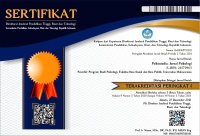Contribution of Emotional Maturity with Behavioral Tendencies of Self-Injury In Adolescents
Abstract
Self-injury as the realization of self-harm is an act of self-harm that is carried out to overcome shocks and mental or emotional pain that is carried out whether intentional or not. Based on previous research sources and journals, it is known that emotional maturity is one of the predictors of the emergence of self-injury behavior tendencies, although there are still other external factors. Specifically, this study focused on the relationship of emotional maturity with the tendency of self-injury behavior in adolescents with the subjects of grade 12 SMA N students in Temanggung as many as 177 respondents. This research is in the form of quantitative research with information in the form of statistical data. Based on the results and analysis of the Spearman-Rho Product-Moment correlation that has been carried out, it is known that the correlation coefficient between the variable X (Emotional Maturity) and the variable Y (Self-Injury) is 0.045 with a Sig. value of 0.278 indicates that there is no correlation of emotional maturity with a tendency to self-injury behavior in adolescents. Furthermore, the value of the contribution of emotional maturity contributed to variable Y, namely self-injury of 4.5% based on the calculation of the correlation coefficient of 0.045 multiplied by 100% and obtained an effective contribution result of 4.5 for variable X to Y. The amount of emotional maturity contribution to the emergence of self-injury behavior tendencies was 4.5% while the rest was influenced by other factors outside of emotional maturity that could trigger the emergence of tendencies self-injury behavior in adolescents. It is hoped that with this research, there will be a lot of knowledge about that emotional maturity only contributes to self-injury behavior.
Self-injury sebagai realisasi self-harm adalah sebuah tindakan melukai diri sendiri yang dilakukan guna menanggulangi guncangan serta rasa sakit mental atau emosional yang dilakukan baik disengaja ataupun tidak. Berdasarkan sumber penelitian dan jurnal terdahulu, diketahui bahwa kematangan emosi menjadi salah satu prediktor munculnya kecenderungan perilaku self-injury, meskipun masih terdapat faktor eksternal lainnya. Secara spesifik penelitian ini berfokus pada hubungan kematangan emosi dengan kecenderungan perilaku self-injury pada remaja dengan subjek siswa kelas 12 SMA N di Temanggung sebanyak 177 responden. Penelitian ini berbentuk penelitian kuantitatif dengan informasi berupa data statistik. Berdasarkan hasil dan analisis korelasi Product-Moment Spearman-Rho yang telah dilakukan, diketahui bahwa koefisien korelasi antara variabel X (Kematangan Emosi) dengan variabel Y (Self-Injury) adalah 0.045 dengan nilai Sig. 0.278 mengindikasikan tidak terdapat kolerasi kematangan emosi dengan kecenderungan perilaku self-injury pada remaja. Selanjutnya pada nilai kontribusi kematangan emosi memberikan sumbangan terhadap variabel Y yaitu self-injury sebesar 4.5% berdasarkan hasil perhitungan koefisien korelasi sebesar 0.045 dikalikan 100% dan memperoleh hasil sumbangan efektif sebesar 4.5 untuk variabel X terhadap Y. Besarnya sumbangan kematangan emosi terhadap munculnya kecenderungan perilaku self-injury sebesar 4.5% sedangkan selebihnya dipengaruhi oleh faktor lain diluar kematangan emosi yang bisa memicu munculnya kecenderungan perilaku self-injury pada remaja. Diharapkan dengan adanya penelitian ini banyak menyumbangkan pengetahuan mengenai bahwa kematangan emosi hanyalah sebagian kecil memberikan kontribusi terhadap perilaku self-injury.
Keywords
Full Text:
FULL TEXTReferences
A. Octavia, Dr. S. (2020). Motivasi Belajar Dalam Perkembangan Remaja. In Motivasi Belajar Dalam Perkembangan Remaja.
Apsari, N. C. (2021). Thesalonika,“Perilaku Self-Harm Atau Melukai Diri Sendiri Yang Dilakukan Oleh Remaja (Self-Harm or Self-Injuring Behavior By Adolescents),.” J. Pekerj. Sos, 4(2), 213–224.
Cipriano, A., Cella, S., & Cotrufo, P. (2017). Nonsuicidal self-injury: A systematic review. In Frontiers in Psychology (Vol. 8, Issue NOV). https://doi.org/10.3389/fpsyg.2017.01946
Cooper, R. (2017). Diagnostic and statistical manual of mental disorders (DSM). In Knowledge Organization (Vol. 44, Issue 8). https://doi.org/10.5771/0943-7444-2017-8-668
Costa, R. P. de O., Peixoto, A. L. R. P., Lucas, C. C. A., Falcão, D. N., Farias, J. T. da S., Viana, L. F. P., Pereira, M. A. de A., Sandes, M. L. B., Lopes, T. B., Mousinho, K. C., & Trindade-Filho, E. M. (2021). Profile of non-suicidal self-injury in adolescents: interface with impulsiveness and loneliness. Jornal de Pediatria, 97(2). https://doi.org/10.1016/j.jped.2020.01.006
Cyril, A. V., & Raj, M. A. (2017). Construction of Emotional Maturity Scale of High School Teachers (AVSEM). Journal on School Educational Technology, 13(1), 49–58.
Dickinson, S. (2021). Post-traumatic growth in the twenty-first century: how current trends may threaten our ability to grow after trauma. The Journal of Positive Psychology, 16(4), 503–511.
Elvira, S. R., & Sakti, H. (2022). EKSPLORASI PENGALAMAN NONSUICIDAL SELF-INJURY (NSSI) PADA WANITA DEWASA AWAL : SEBUAH INTERPRETATIVE PHENOMENOLOGICAL ANALYSIS. Jurnal EMPATI, 10(5). https://doi.org/10.14710/empati.2021.32933
Fadilah, A. N., & Nurhadianti, R. D. D. (2022). Pengaruh Kematangan Emosi Dan Dukungan Sosial Teman Sebaya Terhadap Coping Pada Siswa Kelas Xii SMA Plus YPBH Bogor. Jurnal Psikologi, 4(1).
Fajarini, F., & Khaerani, N. M. (2014). Kelekatan aman, religiusitas, dan kematangan emosi pada remaja. Jurnal Psikologi Integratif, 2(1).
Faried, L., Noviekayati, I., & Saragih, S. (2018). Efektivitas pemberian ekspresif writing therapy terhadap kecenderungan self injury ditinjau dari tipe kepribadian introvert. Psikovidya, 22(2), 118–131.
Febbiyani, F., & Adelya, B. (2017). Kematangan emosi remaja dalam pengentasan masalah. Penelitian Guru Indonesia, 02(02).
Forbes, C. N., Tull, M. T., Richmond, J. R., Chapman, A. L., Dixon-Gordon, K. L., & Gratz, K. L. (2019). Motives for Nonsuicidal Self-Injury in Individuals with Lifetime Depressive Disorders and Posttraumatic Stress Disorder. Journal of Psychopathology and Behavioral Assessment, 41(4). https://doi.org/10.1007/s10862-019-09739-w
Ghazivakili, Z., Lotfi, R., Norouzinia, R., & Kabir, K. (2019). Emotional maturity and mental health among new couples referred to pre-marriage health center in karaj, Iran. Shiraz E Medical Journal, 20(12). https://doi.org/10.5812/semj.89041
Goleman, D. (2006). Emotional Intelligence (Kecerdasan Emosional): Mengapa IE Lebih Penting daripada IQ, penerjemah: T. Hermaya. Jakarta: Gramedia Pustaka Utama.
Gonçalves, S. F., Martins, C., Rosendo, A. P., Machado, B. C., & Silva, E. (2012). Self-injurious behavior in Portuguese adolescents. Psicothema, 24(4), 536–541.
Gratz, K. L., Dixon-Gordon, K. L., Chapman, A. L., & Tull, M. T. (2015). Diagnosis and characterization of DSM-5 nonsuicidal self-injury disorder using the clinician-administered nonsuicidal self-injury disorder index. Assessment, 22(5), 527–539.
Hooley, J. M., Fox, K. R., & Boccagno, C. (2020). Nonsuicidal self-injury: Diagnostic challenges and current perspectives. In Neuropsychiatric Disease and Treatment (Vol. 16). https://doi.org/10.2147/NDT.S198806
Hurlock, E. B. (2011). Psikologi Perkembangan : Suatu Pendekatan Sepanjang Rentang Kehidupan Edisi Kelima. Jakarta : Erlangga, Edisi 5.
Klonsky, E. D., Glenn, C. R., Styer, D. M., Olino, T. M., & Washburn, J. J. (2015). The functions of nonsuicidal self-injury: converging evidence for a two-factor structure. Child and Adolescent Psychiatry and Mental Health, 9(1), 1–9.
Kusasi, M. (2013). Pengaruh manajemen diri dan kematangan emosi terhadap pengambilan keputusan. Psikostudia: Jurnal Psikologi, 2(1), 16–27.
Lally, M., & Valentine-French, S. (2019). Life-Span Development: A Psychological Perspective. Annual Review of Psychology.
Lichtenberg, P. (1955). Emotional maturity as manifested in ideational interaction. Journal of Abnormal and Social Psychology, 51(2). https://doi.org/10.1037/h0043933
Malumbot, C. M., Naharia, M., & Kaunang, S. E. J. (2020). Studi Tentang Faktor-Faktor Penyebab Perilaku Self Injury dan Dampak Psikologis pada Remaja. PSIKOPEDIA, 1(1).
Mathew, A., & Joy, M. (2018). Emotional Maturity and General Well-Being of Adolescents. Article in IOSR Journal of Pharmacy, 8(May 2018).
Moseley, R. L., Gregory, N. J., Smith, P., Allison, C., & Baron-Cohen, S. (2020). Links between self-injury and suicidality in autism. Molecular Autism, 11(1). https://doi.org/10.1186/s13229-020-0319-8
Notosoedirdjo, M. (2014). Latipun, Kesehatan Mental, Konsep dan Penerapan, Malang. UMM Press.
Organization, W. H. (2019). Risk reduction of cognitive decline and dementia: WHO guidelines.
Rai, D., & Khanal, Y. K. (2017). Emotional intelligence and emotional maturity and their relationship with academic achievement of college students in Sikkim. International Journal of Education and Psychological Research ( IJEPR), 6(2).
Seko, Y., & Kikuchi, M. (2021). Self-Injury in Japanese Manga: A Content Analysis. Journal of Medical Humanities, 42(3). https://doi.org/10.1007/s10912-019-09602-9
Sofia, L. (2012). Hubungan Konsep Diri Dan Kematangan Emosi Dengan Motivasi Berprestasi. Psikostudia: Jurnal Psikologi, 1(2), 81–90.
Suharto, M. P., Mulyana, N., & Nurwati, N. (2018). PENGARUH TEMAN SEBAYA TERHADAP PERKEMBANGAN PSIKOSOSIAL ANAK TKI DI KABUPATEN INDRAMAYU. Focus : Jurnal Pekerjaan Sosial, 1(2). https://doi.org/10.24198/focus.v1i2.18278
Takwati, L. S. (2019). Proses Regulasi Emosi Remaja Pelaku Self Injury. Jurnal Riset Mahasiswa Bimbingan Dan Konseling, 5(2), 208–214.
DOI: http://dx.doi.org/10.30872/psikostudia.v12i1.9311
Refbacks
- There are currently no refbacks.
Copyright (c) 2023 Psikostudia : Jurnal Psikologi

This work is licensed under a Creative Commons Attribution-ShareAlike 4.0 International License.
Psikostudia: Jurnal Psikologi is indexed by :
PSIKOSTUDIA: Jurnal Psikologi Published by Faculty of Social and Political Siences, University of Mulawarman, Samarinda, East Kalimantan and This work is licensed under a Creative Commons Attribution-ShareAlike 4.0 International License.
_________________________________________
PSIKOSTUDIA: Jurnal Psikologi
Department of Psychology
Faculty of Social and Political Siences, University of Mulawarman
Jl. Muara Muntai Kampus Gn. Kelua Samarinda 75411
Phone: +62 813 35350368
E-Mail: psikostudia@fisip.unmul.ac.id




















